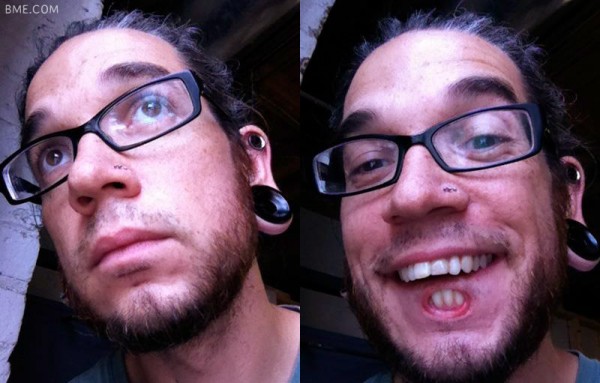Everybody has seen fun pictures of people showing off their teeth through the holes of immense labrets. Now, that’s a great goofy trick if you’re happy with your megalabret and are pleased to pop it back in after the gag photo is snapped, but it’s not so great if you wish you didn’t have that gaping hole in your lip. To refresh your memory as to what I’m talking about, here’s a funny picture of Jared Karnes showing what he does “when people are already being overly dramatic about it” — although most of the time if he’s not wearing jewelry you can barely see the hole, as you can see from the subtle slit on the left side of the image.

Luckily closing these big labrets is not a complex matter as long as the lip has not been stretched dramatically (which would make it more like the reconstruction of a stretched lobe and would almost certainly require a complicated surgery). Here’s one done by Roni Lachowicz, showing the “before” photo, a picture a week later after the stitches were removed, and a fully healed photo a few months later. Since many people naturally have a scar in that location without ever having had a piercing (can someone explain to me why?), it’s unlikely to make much of an impression, especially if hidden under facial hair. Zoom it of course (and most of the other images too).

Speaking of Roni, it’s been a little while since I’ve posted one of the industry’s most striking individuals, so let me give you some eye candy. If memory serves, her eye tattoos are self done, which always impresses the hell out of me. Which reminds me that I should mention that my eye hurts a lot today. I have a bad headache, brought on by central apnea most likely, but it’s manifesting with a great deal of eye pain. I don’t know if it’s real or psychosomatic, but it’s something worth being aware of — real or not, people considering eye tattoos should be aware that even five years later, it can still ache badly from time to time!


And finally — and I know I have really started to drift away from my original subject — I wanted to share one more piece of Roni’s recent work, a great looking tiny little star implant on the flat of the ear. It’s about two weeks old in this photo, so you can see a bit of dry skin over the incision. If this picture was taken even a few days later, you’d have no idea how this implant was inserted, because the incision is so nicely tucked underneath the fold of the helix.












